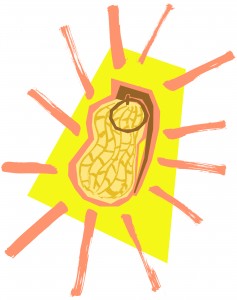WEDNESDAY, 18 JANUARY 2012
Over the past two decades, the number of cases of food allergies has risen sharply, with peanut allergy being one of the most common. For sufferers and their families, this can often mean a decreased quality of life, with constant anxiety over food and the threat of anaphylaxis (a severe, acute multi-system reaction). Despite increased awareness of the condition, it remains a significant public health issue, especially in schools. Here, children may be accidentally exposed to peanuts, present in a variety of foods.Unlike other common food allergies, such as allergies to cow’s milk, most cases of peanut allergy persist into adulthood. Due to the severity and increasing prevalence of peanut allergy, there has been a need for a reliable disease-modifying therapy. In March 2011, it was announced that this had been achieved through the world’s first peanut desensitisation programme, carried out on a group of children in Cambridge over the last three years.
In the 1960s, the antibody immunoglobulin E (IgE) was discovered—a significant breakthrough in the study of the mechanisms of allergy. Allergic reactions are caused by allergens cross-linking preformed IgE molecules, which are bound to receptors on mast cells. Mast cells line body surfaces and alert the immune system to local infection. They induce inflammatory reactions through the secretion of chemical mediators and synthesis of signalling molecules like prostaglandin and leukotriene. In an allergic response, they provoke unpleasant reactions to mild antigens. There is usually an immediate and a late-phase response. The initial inflammatory response happens within seconds. This is followed by a late reaction that develops over 8 to12 hours, involving the recruitment of other effector cells such as lymphocytes. In the case of re-exposure to an allergen, the preformed mediators causing the immediate reaction (an increase in vascular permeability and smooth muscle contraction) are short-lived and their powerful effects are confined to the vicinity of the activated mast cell. The more sustained late-phase reaction is due to the synthesis and release of signalling molecules from the mast cells.This is also focussed on the initial activation site, and it is the anatomy of this site that determines how quickly the inflammation can be resolved. Thus, the clinical syndrome arising from an allergy depends on the amount of allergen-specific IgE present, the route of allergen entry and the dose of the allergen.
Allergy symptoms can vary from a runny nose in hay fever (due to inhalation of pollen), through to the collapse of the circulatory system, which occurs in systemic anaphylaxis. This can give rise to a variety of fatal effects—widespread vascular permeability leads to a sharp decrease in blood pressure; airways constrict, causing breathing difficulties; the epiglottis swells, leading to suffocation. This fatal combination is anaphylactic shock, and can occur in peanut allergy sufferers on exposure to the allergen.
Despite all the precautions taken by sufferers to avoid peanuts, there are still a significant number of accidental reactions each year, some of which are severe. The number of children admitted to hospital for general food-related anaphylaxis has increased by 700 per cent since 1990. Researchers have long been trying to find a safe and effective therapy for peanut allergy. Immunotherapy for stinging insect allergy by injection has proved effective, as has oral immunotherapy (OIT) for hen’s egg and cow’s milk allergy. It was this OIT method that was first investigated three years ago by doctors at Addenbrooke’s Hospital as a treatment for peanut allergy. The OIT approach distinguished it from similar previous, but unsuccessful, desensitisation programmes, since these had used peanut injections and not the more gentle oral doses.
Four children allergic to peanuts and aged 9 to13 years were enrolled in the study, all with a history of eczema, a positive peanut skin prick test and positive peanut serum-specific IgE. They initially took a five milligram serving of peanut protein, then increased this dose over a period of six months, training their bodies to tolerate at least 800 milligrams of peanut protein per day—160 times the starting amount and equal to five whole peanuts. The subjects continued taking 800 milligrams of peanut protein each day for the following six weeks, after which three of them were able to tolerate the equivalent of 12 peanuts without reaction, and the fourth was able to tolerate 10. There was clearly an improvement in the tolerated dose in all four children, including one who had suffered from anaphylaxis on initially ingesting five milligrams of peanut flour. The OIT had enabled them to ingest at least 10 peanuts without adverse consequences, far more than they would be likely to encounter accidentally, the main cause of anxiety for peanut allergy sufferers.
Following on from this, a further 18 children aged 4 to18 years were enrolled in the study and underwent OIT. The dosage was first gradually increased to 800 milligrams of peanut protein per day, then the highest tolerated dose (a target of 800 milligrams per day) was taken for 30 weeks. After treatment, 19 of the 22 children were able to eat at least five peanuts per day, with two eating two to three per day and the last dropping out at the start of the study. Additionally, the skin prick test response was much reduced at 6 and 30 weeks. Peanut-specific IgE levels showed a transient rise partway through OIT, followed by a reduction at 30 weeks compared with pre-OIT values. Overall, the amount of peanut that could be tolerated by the subjects increased 1,000-fold—a significant amount, especially for those who had previously reacted to just one milligram of peanut protein.
Researchers are currently working to make this revolutionary treatment more widely available. This would be invaluable to children and adults with severe peanut allergy and low-dose threshold. The children studied represented various severities of allergy, some with a history of anaphylaxis. This peanut allergy investigation is the first to be successful, making it possible for patients to lead a more normal life. Considering the powerful effects of an allergic reaction, it is easy to see why this is such an important breakthrough: for the most severely-affected patients, their previously incurable allergy could soon become a thing of the past.
Mrinalini Dey is a 2nd year undergraduate in the Department of Medicine


